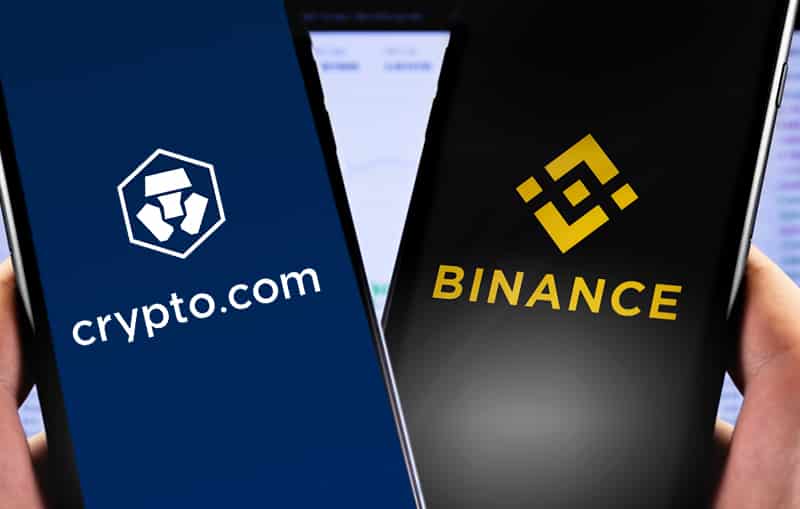One of the most vital aspects of succeeding in the crypto trade is choosing the right exchange. More so, if you’re a beginner, you don’t want an exchange that doesn’t offer the coins you intend to trade or one that charges exorbitant fees. Most importantly, you want an exchange that protects you and your funds from hackers and fraudsters. You cannot go wrong with either Binance or Crypto.com. However, how do these two giants compare?
About Crypto.com
Founded in 2016, Crypto.com has successfully managed to position itself among market leaders in the crypto exchanges space by being the fastest-growing platform. It serves more than 10 million clients, with a staff of more than 900 employees. Some of its outstanding features include a Visa crypto card that returns 8% of all spending to the holder, a hot wallet that features a mobile app, and a credit service that gives out crypto loans.
Recently, the platform launched an NFT marketplace for its users. What’s more, they have a long-standing reputation of having no fraud or hacking cases on record since the platform’s inception.
About Binance
Established in 2017, Binance has since grown to become the largest crypto exchange by traded volume. It sees a daily turnover of $27.76 billion, which completely dwarfs Crypto.com’s daily transaction volume of $4.32 million. This can be attributed to its long list of cryptocurrencies on offer, numbering more than 500.
Additionally, users can trade more than 1,000 crypto pairs on the platform. It also features a futures and derivatives market, margin trading, and spot exchange. What’s more, like its counterpart, it also features an NFT marketplace.
Head to head comparison
1. User interface
Both platforms offer a standard UI on their sign-up page. Crypto.com has a beginner-friendly mobile app that is compatible with both Android and iOS devices. The app makes the crypto trading process easy, and transferring tokens from one wallet to another is pretty straightforward. It also features an advanced trading platform for more seasoned traders, which enables them to create sophisticated chart structures.
Binance’s UI is somewhat similar to that of its counterpart, but it is a little more complex than Crypto.com’s. The steep learning curve it offers may turn off some beginners, especially if they visit the Binance desktop app. So when it comes to user-friendliness, Crypto.com wins this round.
2. Security
Binance is based on the Cayman Islands, which enables it to operate in a fairly unregulated environment. This has caused the platform to rub shoulders with different financial bodies around the world, and it is currently under investigation by several regulators. What’s more, the platform was hacked in 2019 to the tune of 7,000 BTC. Since then, it has made efforts to compensate affected investors from its Secure Asset Fund, as well as upgrade its security measures.
Crypto.com has never reported any hacks. The platform offers multi-factor authentication and anti-phishing measures. They also hold the entirety of their client’s balance in cold storage to keep it away from these hackers.
3. Fees
Both platforms have a similar fee structure, as they both charge maker and taker fees based on their clients’ trading volume. On Binance, a monthly trading volume below 50 BTC is charged a maker and taker fee of 0.1%. However, if the client uses Binance’s native BNB coin to make these payments, they get a 25% discount.
Crypto.com charges a 0.05% maker fee and a 0.07% taker fee for all their clients averaging monthly trading volumes of less than $25,000. Volumes below $50,000 are charged a maker fee of 0.04% and a taker fee of 0.065%.
4. Sign-up process
Both platforms have pretty similar sign-up processes. They both require their clients to undergo Know Your Customer (KYC) and Anti-Money Laundering (AML) protocols to verify their accounts. On Binance, the more documents you submit for verification, the higher the VIP status you’re afforded. Higher VIP status allows you to withdraw larger volumes from your wallet. However, these verification processes take quite some time to go through.
On Coinbase, in contrast, the sign-up process is quick, and account verification is promptly approved.
5. Cryptocurrencies on offer
The lack of regulation that Binance enjoys allows it to easily add new projects onto its offering. On the platform, users can access more than 500 crypto coins, as well as more than 1000 crypto pairs. Crypto.com, in comparison, offers only about 150 crypto tokens.
6. Defining features
Arguably, the most redeeming feature of Crypto.com is their Visa card that allows their clients to spend crypto and get an 8% cashback with each purchase. However, these rewards are paid out in the platform’s native token, CRO, which oftentimes tends to be volatile. Additionally, users can earn interest on their holdings on the platform. What’s more, they offer a DeFi service that allows users to swap various DeFi tokens.
Binance, on the other hand, stands out most in the wide variety of cryptocurrencies they offer, as well as the numerous pairs on the platform. Additionally, they offer derivatives, perpetual swaps, and crypto futures. However, trading these derivatives is highly risky. The fact that Binance is the largest exchange by volume also means that it offers the most liquidity.
The bottom line
Both platforms we’ve looked at are excellent choices for a crypto enthusiast. The choice between them boils down to your individual needs as a trader. If you’re looking to trade undervalued, upcoming tokens, Binance would be your best bet. The same goes for if you intend to trade crypto derivatives or futures. If, instead, you’re looking for a highly secure, regulated platform, and you have no desire to trade outside the mainstream coins, Crypto.com would be your best bet. You should also choose this platform if you fancy spending your crypto using a credit/debit card.



